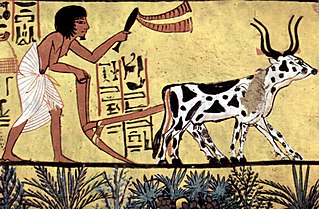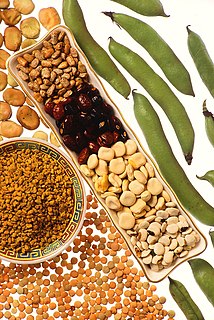
Crop rotation is the practice of growing a series of different types of crops in the same area across a sequence of growing seasons. It reduces reliance on one set of nutrients, pest and weed pressure, and the probability of developing resistant pest and weeds.

Intensive agriculture, also known as intensive farming and industrial agriculture, is a type of agriculture, both of crop plants and of animals, with higher levels of input and output per cubic unit of agricultural land area. It is characterized by a low fallow ratio, higher use of inputs such as capital and labour, and higher crop yields per unit land area.

In agriculture, rotational grazing, as opposed to continuous grazing, describes many systems of pasturing, whereby livestock are moved to portions of the pasture, called paddocks, while the other portions rest. Each paddock must provide all the needs of the livestock, such as food, water and sometimes shade and shelter. The approach often produces lower outputs than more intensive animal farming operations, but requires lower inputs, and therefore sometimes produces higher net farm income per animal.

A legume is a plant in the family Fabaceae, or the fruit or seed of such a plant. When used as a dry grain, the seed is also called a pulse. Legumes are grown agriculturally, primarily for human consumption, for livestock forage and silage, and as soil-enhancing green manure. Well-known legumes include alfalfa, clover, beans, peas, chickpeas, lentils, lupins, mesquite, carob, soybeans, peanuts, and tamarind. Legumes produce a botanically unique type of fruit – a simple dry fruit that develops from a simple carpel and usually dehisces on two sides.
In agriculture, green manure is created by leaving uprooted or sown crop parts to wither on a field so that they serve as a mulch and soil amendment. The plants used for green manure are often cover crops grown primarily for this purpose. Typically, they are ploughed under and incorporated into the soil while green or shortly after flowering. Green manure is commonly associated with organic farming and can play an important role in sustainable annual cropping systems.

In agriculture, cover crops are plants that are planted to cover the soil rather than for the purpose of being harvested. Cover crops manage soil erosion, soil fertility, soil quality, water, weeds, pests, diseases, biodiversity and wildlife in an agroecosystem—an ecological system managed and shaped by humans. Cover crops may be an off-season crop planted after harvesting the cash crop. They may grow over winter.

Nutrient management is the science and practice directed to link soil, crop, weather, and hydrologic factors with cultural, irrigation, and soil and water conservation practices to achieve optimal nutrient use efficiency, crop yields, crop quality, and economic returns, while reducing off-site transport of nutrients (fertilizer) that may impact the environment. It involves matching a specific field soil, climate, and crop management conditions to rate, source, timing, and place of nutrient application.
Monocropping is the agricultural practice of growing a single crop year after year on the same land, in the absence of rotation through other crops or growing multiple crops on the same land (polyculture). Maize, soybeans, and wheat are three common crops often grown using monocropping techniques.

The three-field system is a regime of crop rotation that was used in China since ancient times and in medieval and early-modern Europe. Crop rotation is the practice of growing a series of different types of crops in the same area in sequential seasons.

In agriculture, a living mulch is a cover crop interplanted or undersown with a main crop, and intended to serve the purposes of a mulch, such as weed suppression and regulation of soil temperature. Living mulches grow for a long time with the main crops, whereas cover crops are incorporated into the soil or killed with herbicides.

The soybean cyst nematode (SCN), Heterodera glycines, is the most devastating pest to crop yields in the U.S.,[5] targeting the roots of soybean and other legume plants. When infection is severe SCNs cause stunting, yellowing, impaired canopy development, and yield loss.[4] The symptoms caused by SCNs can go easily unrecognized by farmers. Due to the slight stunting and yellowing, many farmers may mistake these symptoms as environmental problems when in fact they are SCNs.[2] Due to the fact that soybean cyst nematodes can only move a few centimeters in the soil by themselves, they mostly are spread via tillage or plant transplants. This area of infection will look patchy and nonuniform making diagnosis more difficult for farmers.[4] They can be seen in the roots of summer soybean plants if the roots are taken out very carefully and gently washed with water. The egg masses should be seen as bright white or yellow “pearls” on the roots. The later the roots are pulled the harder it will be to diagnose due to the SCNs female dying and turning a much darker color, forming a “cyst”.[6] The best way to know if a field is infected by soybean cyst nematodes is to take a soil sample to a nematologist.
A long-term experiment is an experimental procedure that runs through a long period of time, in order to test a hypothesis or observe a phenomenon that takes place at an extremely slow rate. What duration is considered "long" depends on the academic discipline. For example, several agricultural field experiments have run for more than 100 years, but much shorter experiments may qualify as "long-term" in other disciplines. An experiment is "a set of actions and observations", implying that one or more treatments is imposed on the system under study. Long-term experiments therefore contrast with nonexperimental long-term studies in which manipulation of the system studied is impossible or undesirable.

The Cullars Rotation is a soil fertility experiment on the Auburn University campus in Auburn, Alabama and is listed on the National Register of Historic Places. The Cullars Rotation experiment, which started in 1911, is the oldest ongoing cotton fertility experiment in the United States, the oldest soil fertility experiment in the Southern United States, and the second oldest continuous cotton experiment in the world.

The Morrow Plots is an experimental agricultural field at the University of Illinois at Urbana-Champaign. Named for Professor George E. Morrow, it is the oldest such field in the United States and the second oldest in the world. It was established in 1876 as the first experimental corn field at an American college and continues to be used today, although with three plots of much reduced size, instead of the original ten half-acre lots. The site was designated a National Historic Landmark on May 23, 1968. The fields are managed by the College of Agricultural, Consumer, and Environmental Sciences.

Thlaspi arvense, known by the common name field pennycress, is a flowering plant in the cabbage family Brassicaceae.

Intensive crop farming is a modern form of farming that refers to the industrialized production of crops. Intensive crop farming's methods include innovation in agricultural machinery, farming methods, genetic engineering technology, techniques for achieving economies of scale in production, the creation of new markets for consumption, patent protection of genetic information, and global trade. These methods are widespread in developed nations.
The Illinois Soil Nitrogen Test ("ISNT") is a method for measuring the amount of Nitrogen in soil that is available for use by plants as a nutrient. The test predicts whether the addition of nitrogen fertilizer to agricultural land will result in increased crop yields.

Rodale Institute is an American 501(c)(3) nonprofit that supports research into organic farming. The Institute was founded in 1947 by entrepreneur J.I. Rodale in Emmaus, Pennsylvania. When J.I. Rodale died in 1971, his son Robert purchased 333 acres and moved the farm to its current site in Kutztown, Pennsylvania.

A biofertilizer is a substance which contains living micro-organisms which, when applied to seeds, plant surfaces, or soil, colonize the rhizosphere or the interior of the plant and promotes growth by increasing the supply or availability of primary nutrients to the host plant. Biofertilizers add nutrients through the natural processes of nitrogen fixation, solubilizing phosphorus, and stimulating plant growth through the synthesis of growth-promoting substances. The microorganisms in biofertilizers restore the soil's natural nutrient cycle and build soil organic matter. Through the use of biofertilizers, healthy plants can be grown, while enhancing the sustainability and the health of the soil. Biofertilizers can be expected to reduce the use of synthetic fertilizers and pesticides, but they are not yet able to replace their use. Since they play several roles, a preferred scientific term for such beneficial bacteria is "plant-growth promoting rhizobacteria" (PGPR).

The Magruder Plots are experimental winter wheat field plots at Oklahoma State University established in 1892. They are the third longest-running such field trial in the United States, following the Morrow Plots established in 1876 at the University of Illinois at Urbana–Champaign, and the Sanborn Field established in 1888 at the University of Missouri. They are examples of long-term experiments.























